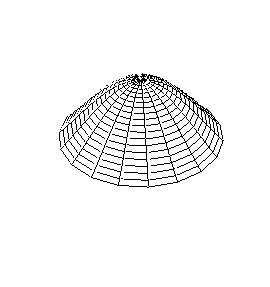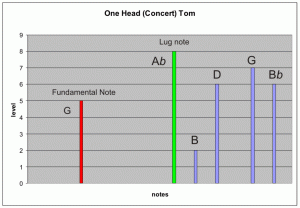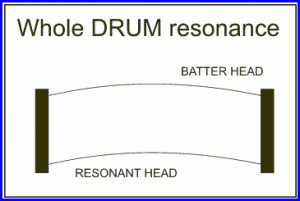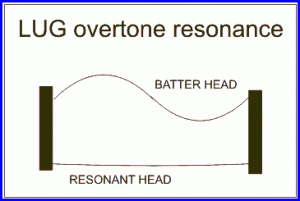About Drums by John Roberts
When we say we are “tuning” a drum, what does that really mean? With the exception of kettledrums and tympani, drums do not make single identifiable notes when played. Drums actually make several different notes simultaneously.
What we call “tuning” mainly consists of several steps. 1) voicing the batter head tension for the initial lug note sounded when struck. 2) voicing the resonant head for agreeable after-ring decay after the drum strike. 3) clearing the lugs to perfectly agree with each other. This third step is the secret sauce that makes the difference between a drum that measures like it should be in tune, and one that sounds like it is in tune.
Even if a note sniffer says every lug is voicing the same lug resonance, they can still disagree at higher overtones. When a drum sounds multiple closely spaced higher overtones they interfere against each other and create dissonance. When those higher overtones are also in tune the result is a simpler, cleaner drum sound without the harsh dissonance.
The Physics of Overtones
Typical musical instruments play only one note at a time, one note per guitar string or one note per piano key. These notes can contain multiple higher frequency harmonics that define their complete sound character. These overtones generally fall on perfect harmonic ratios due to how these musical sounds are created. Even though they are different frequencies, they all combine to sound like a single musical note with complex sound character.
In a musical instrument that vibrates a string under tension, or a wind instrument that vibrates a column of air, the wavelength of the sound generated is defined by a physical dimension like the length of the string or length of the air column. Wavelength, just like the word sounds, is the length of a single waveform, beginning at zero, looping up before reversing to pass down through zero to loop below then return back up to zero again to start over. These zero points in the wavelength are called nodes, and these points of zero movement line up with hard physical boundaries. The endpoints of a string where it is firmly attached or the closed end of an organ pipe form natural nodes. The open end of an organ pipe is where the natural anti-node (peak amplitude) occurs so that length is for a 1/4 wavelength. String length and drumhead dimension nodes define full or 1/2 wavelengths.
The frequency or pitch of the fundamental note is determined by how fast sound travels in the vibrating medium and how far that sound must travel. The “period” of a waveform is the time it takes to form one complete wavelength. The frequency or pitch of this waveform is the mathematical reciprocal of this period or 1/period. To make different pitch notes in a pipe organ you use different length pipes. When playing a guitar you can make the effective length of the vibrating string shorter and therefore shift the note pitch up higher by pressing the string hard against a fret to form a new end point or node there. The shorter the length of vibrating string, the higher the note pitch it makes. The multiple guitar strings on one guitar are made using different diameter (weight) wire, so when the same length, they make a musically useful ratio or spread of notes. String tension is also varied to fine tune the actual notes.
An important difference about how higher pitch overtones develop in these conventional musical instruments, as compared to drums, is that conventional musical instrument overtones travel over the exact same physical path as the fundamental note. Since the overtone wavelength nodes must line up at the same physical boundaries, the overtones only meet these criteria for full multiples, like 2, 3, or N complete wavelengths fitting neatly into the same fundamental wavelength path. Doubles of the fundamental pitch make harmonic overtones that fall on the same musical notes but in higher octaves (2nd, 4th, 8th etc).
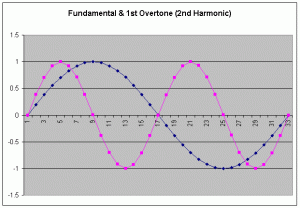
The Physics of Overtones in Drums
Unlike conventional musical instruments where the sound energy vibration is limited to a one-dimensional path, sound vibrations in a drumhead can travel anywhere within a round two-dimensional space. The distance straight across the drumhead defines one wavelength series. A round zero movement node is established by the fixed rim-edge drumhead attachment. As we can see in the far left hand animation below viewing a drumhead vibrating at the fundamental resonance, from the side looks like one half of a sine wave, with alternating up and down motion.
Loudspeaker diaphragms generally move in and out as a single rigid surface operating in what is called “piston motion”. When a loudspeaker driver diaphragm starts vibrating across it’s diameter like a drumhead, making higher frequency overtones, these are called “break-up” modes and undesirable. When drumheads do this it’s just normal drum behavior.
Fundamental mode (0,1) 1x This is the lowest frequency resonance that drums vibrate in.
Lug mode (1,1) 1.593x fundamental This is the next higher resonance above the fundamental that drums vibrate in. This resonance is the one used for matching lug pitch in various tuning strategies.
Lug mode (2,1) 2.135x fundamental This is the next higher resonance above Lug mode. For one headed concert toms mode (1,1) is suppressed and this is the dominant Lug mode used for tuning.
The wavelength for other series of resonances traces circular paths around and across the middle of the drumhead. Since the circumference or distance around a circle is “pi” (3.14) times the distance across the same circle, there are multiple different non-integer ratios between the drum fundamental pitch and higher pitched drumhead overtones. These non-integer ratios cause drumhead overtones to fall on different notes. Vibration mode 1,1 and 2,1 have a fixed node at the midpoint and additional nodes and anti-nodes that fall on a circle mid-way between the center point and rim edge. Other vibration series fall on other smaller circles, and one higher overtone series has an anti-node (peak) dead center again, similar to the lowest fundamental.
When only one head is mounted, like on a “concert tom”, mode (1,1) is weak and mode (2,1) dominates the first overtone. The chart below shows a series of typical notes and levels with the fundamental (in red), first overtone (in green), and higher resonances (in blue). These readings were made using a RESOTUNE II to excite the drumhead with sound energy from it’s internal loudspeakers. Resonances excited by drumstick hits will preferentially excite the resonances louder that have anti-nodes (local maximums) directly under where the drumhead is hit. For example the fundamental note is most excited by striking the drumhead dead center where it has the largest up/down movement or excursion. Higher pitch resonances generally have peak activity away from the drumhead center point, so respond more when the head is struck off-center. Hitting even closer to the rim edge excites even higher pitched overtones.
Observe that these notes are not on useful musical intervals and do not make some euphonious drum chord. Instead they are a characteristic mix of different notes that drummers can play louder or softer selectively by how and where they strike the drumhead. The concert tom is preferred by some drummers for it’s characteristic sound. With only one head, the sound is also more repeatable than from using two headed drums because there isn’t a second different tensioned head interacting with the first head differently at different resonances. All concert toms will exhibit the same characteristic ratio between notes, while two headed drums will vary more with voicing.
The most important sound characteristic of a one-headed or concert tom is the spacing between the lowest note fundamental and the first (lug) overtone. The span between G and Ab is musically just the next note higher but in reality it is over one full octave higher. If we look at the standard vibration modes for a round flat vibrating disc we see this spacing agrees with the lug overtone being vibration mode (2,1) at 2.135x above the fundamental. Vibration mode (1,1) falls in the middle between them at 1.593x, but is not active in concert toms. That vibration mode apparently needs the bottom head to support a strong resonance. When we tension a one headed drum tighter, this increases the speed of sound traveling across and around the drumhead, like tightening a guitar string, so all the note pitches shift up higher together, while maintaining the same ratio between resonances and makes the same characteristic sound just at higher pitch.
If one head is good two must be better?
We are most familiar with two headed drums. Adding a second head to the system doubles the vibrating mass since the two heads will both vibrate together for some resonances even though only the batter head is the one being hit. This extra vibrating mass sustains longer after being hit. There are multiple mechanical and acoustic pathways between these two heads to transfer energy back and forth. The most obvious is the air path coupling the two heads together. Another path for sound energy transfer is to mechanically couple vibration from the batter head through the rim into the shell, through the shell down into the bottom rim and into the resonant head. These different pathways will exhibit different transit times, different coupling efficiency, and even resonances of their own. Coupling between the heads can be constructive, destructive, or neither for different pitch head resonances. If a drum shell’s natural resonant pitch agrees with one or both drumhead resonances, the coupling between them at that resonance could be enhanced. In practice most shells have so much hardware bolted to them that any natural free vibration mode will not be very pure, while simple mechanical sound transmission will clearly occur. Investigating the full effects of shell interaction is beyond this general overview of tuning and the shells are not adjustable anyhow. Drums made with different shell depth and from different shell materials will behave and sound different.
One relatively simple mechanism to inspect is the acoustic coupling directly through the air path between the two heads. When the top batter head is struck dead center, it bows inward and compresses the air inside the drum. This momentary pressure increase pushes down on the bottom resonant head, moving it down in the same direction. As the top head swings back up, due to the restoring force of it’s spring compliance, it generates a reduced internal pressure, sucking the bottom head up with it. At the fundamental (lowest) note resonance, these two heads move up and down together as a single connected system. The mass and tension of both heads influence the pitch of this combination fundamental note. Changing the tension of the bottom head will shift the fundamental pitch of the top head because they both vibrate together. In theory there is a resonance mode where these two heads move in the exact opposite direction from each other, but this mode, dissipates energy quickly from squeezing and stretching the air inside the drum, so should decay quickly. It could be supported by a shell resonance wavelength that has a node at one rim edge and anti-node at the other rim edge of the shell.
Many of the higher overtone series do not compress the air inside the drum between the two heads, because after the initial pulse, a standing wave forms in the drumhead that causes one half of the drumhead to be moving up whenever the other half is moving down, and vice versa. When one half of the batter head is always going up at the same time as the other half of the head is going down, the air inside the drum is not being squeezed and less sound energy couples through this pathway to the opposite head. The initial pulse, before the standing wave builds up, will cause some direct energy transfer to the opposite head. The impact of this depends on how the top and bottom head resonances are set relative to each other. Unlike the fundamental resonance that involves both heads, the lug overtone and most higher overtones are local to just each head independently. If the two heads are tensioned precisely alike, this pulse from a strong hit will excite the resonant head sympathetically. If the two heads are tensioned differently, or have different mass, causing a different resonance pitch, the sympathetic resonance is less pronounced.
Often the two heads are intentionally tensioned to slightly different lug resonances to reduce the amount and duration of sustain. This can also subtly shift the after-ring. All drums will experience a slight drop in pitch between the initial attack and the after-ring, because the head deflection from the initial high amplitude vibration transiently increases the head tension shifting the pitch up. As this amplitude drops and the tension relaxes, the pitch glides lower.
If we re-inspect the resonances in that exact same tom batter head as measured above, but this time with a similar weight resonant head mounted to the bottom of the shell, and tensioned to the same lug resonance note pitch, we see an interesting change. The top head lug resonance remains the same note pitch, as before, since that head tension has not changed, but now the fundamental note pitch has been pulled up to a higher note pitch. It is not immediately obvious that the higher mass of two heads vibrating together would vibrate faster, but this is not a simple relationship.
Resonance in any mechanical system is characterized as the conversion back and forth between the kinetic energy of the drumhead mass moving up and down into the potential energy of a spring stretching and relaxing. The head stretching is this spring. The frequency of such resonances is influenced by one divided by 2 pi times the square root of the ratio between this spring rate divided by the mass. The head mass for a two head drum is a simple double, and now even the air mass captured between the two heads adds to and becomes part of the combined system increasing the vibrating mass, but there are now two springs or edge compliances between the head and rim system in parallel. The effective spring rate for two same size heads in parallel is stiffer than one proportionately larger head and the resonant note reflects that by being a higher pitch.
The note spacing now between fundamental and lug overtones are consistent with disc vibration mode (1,1) or 1.593x. Instead of the fundamental being the same and all the higher resonances shifting, the lug resonance stays the same as before and the fundamental note shifts up.
This tighter spacing between fundamental and lug overtone is the first significant difference between using one head and two, but there is another important difference. The ratio between lug overtone and fundamental is no longer rigidly fixed to follow a hard ratio based on the head dimension, but the relative mass and tension of the two heads can now shift the fundamental and associated resonances up or down, relative to the other resonance series. We now have a much wider palate of voicing possibilities defined by the relative tension and weight of the two heads.
For similar weight heads, you can completely characterize the voicing of a two-headed drum by measuring the top and bottom head lug resonance notes. Noting these two Lug notes (and head weights) will allow you to always return to a favorite drum voicing. By replicating these Lug notes and heads used, you can make different drums sound more alike (if desired), while mechanical characteristics of the shell and hardware between different drums can affect the higher resonances subtly.
We do not believe that there is only one ideal voicing for all drums so decline to give specific voicing advice. We observe that it is popular to de-tune the bottom resonant head slightly higher or slightly lower pitch than the batter head lug note, but even this is not universal. Here is a link to one pretty comprehensive general discussion of tuning and voicing drums Prof sound-Drum tuning bible . We are inclined to downplay any tuning advice that argues that there is only one way to voice a drum that sounds good. There are multiple different opinions published. We suggest that you try them all and take time to experiment and find your own personal voice.
If drum tuning is not just about note pitch what is it about?
Now we come to the major source of confusion surrounding this topic. Why can drums be adjusted to make the same note pitch at a given resonance, but exhibit such different sound quality? The attachment method of using multiple lugs spaced around the drumhead circumference to tension the drumhead can cause very audible sound quality differences when the lug tensions are not very closely matched to each other. The fundamental note pitch tracks with the average head tension so half of the lugs could be too tight and the other half too loose while still making the same fundamental note pitch. However as we inspect the behavior at higher vibration modes we find progressively more significance attached to individual lug tension and the matching between these lugs. These slight tension differences along with tiny mechanical imperfections in the drum construction can cause significant audible differences.
If the lugs are not in perfect agreement with each other, instead of just making the lowest possible number of overtone notes, sounding pure when played, we hear instead a much more complex dissonant sound character from multiple closely spaced overtones. This state of perfect tune when all the lugs are in complete agreement with each other is called “clear” or “clearing” the head, because the sound character of the drum appears to open up, or clean up, sounding more pure, or as pure as it can possibly sound from that mix of non-related drum notes.
________________________________
Unusual or special drums
The Bass/Kick drum: is generally just a larger tom, laying on it’s side. One import distinction about Kick drum sound is related to how it is struck. The fixed foot pedal beater strikes the drumhead dead center. That preferentially excites the fundamental resonance. As we recall from the concert tom discussion, when the resonant head is not mounted, the fundamental note pitch generated is lower frequency, perhaps desirable for a kick drum.
There are also after-market products that form a port with a hole in the kick drum resonant head. Without doing a detailed analysis of the physic involved, this is probably a combination of adding mass to the head with some acoustic effect from the port. I’ll leave it to others to determine what is really controlling resonances and note pitch with those.
The Snare drum: is another variant on the two head tom for dominant head resonances, but in addition there are wire snares strung across the resonant head. While these snares do not vibrate like a musical instrument string, instead they rattle up against resonant head, but in a musically pleasing way. The shell of typical snare drums is shorter than most toms, and far more rigid, often made of dense metal or sometimes very thick wood. This increases the mechanical transmission though the shell from the top batter head down into the resonant end rim and snares.
The conga drum is a variant on the one-headed concert tom with similar resonant series note ratios. In addition the longer shell forms a tuned resonant air column, like a very short organ pipe, or a long loudspeaker port. This extra acoustic structure can enhance a lower note resonance.
The tympani and kettledrum are special cases of one headed drums designed for orchestral use that are perceived as making single note pitches when played. Their sealed back air cavity suppresses resonances like the typical lowest fundamental mode (0,1), that would compress the internal captive volume of air. Their sound character is dominated by vibration modes (1,1), (2,1), (3,1), etc. where half the drum head area is moving up while the other half is moving down so don’t increase or decrease the internal air pressure.
The tympani/kettle drum is designed so that these lower resonances fall on a pitch spacing that while not perfect harmonics of each other, this spacing mimics them being upper harmonics above a missing lower phantom fundamental note. Our brain is trained to interpret that specific overtone spacing, based on our experience with naturally occurring musical sounds. Our brain assumes this missing lower note must be present, and hears the complex note as if the missing fundamental was present. This musical psycho-acoustic trickery allows the tympani/kettle drum to appear to make notes at lower note pitch than their physical dimensions can actually support.
Practical issues with note targeting
Only one major drum manufacturer, that we are aware of (DW) provides a note target for their drums. They call this “Timbre-Match” (r) and identify this as the shell note pitch. From discussion with DW techs this should be coordinated with the lug resonance so it can also be targeted while using tap tuning, or any of the electronic sniffer variants providing specific pitch information. Timbre-Match (r) is a registered mark or Drum Workshop, Inc.
Special drumheads and damping rings
While discussing all of the head variants is also beyond the scope of this overview I have some general observations. Many of the exotic drumhead designs attempt to squelch the higher overtones to reduce the apparent dissonance of a poorly cleared drumhead. If the upper overtones are damped you can’t hear how un-clear they are. Damping also reduces sustain, if the drumhead doesn’t sound great when you hit it, why let it sound that way even longer? So my suspicion is that many of these trick drumheads are designed to conceal the sound of not being well tuned or “cleared”.
There is one alternate head technology with some actual physics behind it. The “dot” heads have a small mass added right at the center mid-point of the drumhead. For the vibration modes (like 1,1 and 2,1) where the exact mid-point node is sitting dead still, this added mass has no effect. However for the fundamental mode (0,1), this midpoint is now an anti-node and moving vigorously up and down. As we should recall from the mass/spring rate discussion, mass is in the denominator of the natural frequency equation, so more mass makes a lower note. The goal is to shift the fundamental note of a two head drum down from the nominal 1/1.593x, to 1/2x or one full octave spacing a useful ratio that makes the same note only in a different octave.
Different weight top/bottom heads
We still decline to give specific voicing advice but in general the tension and mass of a head affects stick feel as well as rate of sound decay. Using different weight heads on the top and bottom can make subtle voicing differences similar to de-tuning. Experiment and try different combinations, if you like the way some combination sounds use it. If you don’t like the sound, don’t use it.
Note spread across toms
Before you lose too much sleep trying to decide which resonant series to target to be precisely on note, since they all can’t all be tuned exactly on full notes, lets look at the popular practice of establishing a musical spread of note pitches across your different toms. If all the batter and resonant heads are the same weight or same ratio of weights, with similar relative tuning, a musical note spread of lug resonances will map out directly to the same note spread of fundamental resonances. While only one or the other set of resonances can be tuned to fall precisely on full notes. Don’t lose any sleep over this. One clue about whether you might favor tuning the fundamental or lug resonance to be on note, when you play a run across your toms do you hit them dead center making the “thud” fundamental sound, or do you hit them off center exciting more of the lug overtone ring? Again do not lose one moment of sleep over this.
Conclusion
A well-tuned drum kit that sounds great is more fun to play and sounds better to everybody else too. If a drum is worth playing it is worth tuning as well as you can. Despite writing far too much about specific notes, the perceived sound quality of a drum kit is most influenced by clear quality, and how pure it sounds, Not making just one of the several different notes fall precisely on some note target. Adjust the lug tension so it feels good when you hit it. Clear the lugs to each other so the head is only making the smallest number of different notes instead of a complex dissonant mess, and enjoy yourself. Even if you don’t have access to the latest technology, do the best job you can using whatever tools you have available (even if just your ears and a well placed finger). We hope this information is helpful.
Reading for extra credit
The math and physics describing these resonances is beyond our basic discussion but for more information on drumhead physics see Acoustics and Vibration Animations – Dan Russell, Kettering University
I also highly recommend the book “Science of Percussion Instruments” by Thomas D. Rossing for a broad technical discussion of several different types of percussion instruments.
A link describing old school “tap-tuning” , by an old friend Steve Volpp who knows a little about drums.
A link to lots of general information about tuning and voicing drums. Prof sound
Glossary:
Note frequency in Hz over several octaves re: A=440
| B | 493.9 | 246.9 | 123.5 | 61.7 | 30.9 |
| Bb | 466.2 | 233.1 | 116.5 | 58.3 | 29.1 |
| A | 440.0 | 220.0 | 110.0 | 55.0 | 27.5 |
| Ab | 415.3 | 207.7 | 103.8 | 51.9 | 26.0 |
| G | 392.0 | 196.0 | 98.0 | 49.0 | 24.5 |
| F# | 370.0 | 185.0 | 92.5 | 46.2 | 23.1 |
| F | 349.2 | 174.6 | 87.3 | 43.7 | 21.8 |
| E | 329.6 | 164.8 | 82.4 | 41.2 | 20.6 |
| Eb | 311.1 | 155.6 | 77.8 | 38.9 | 19.4 |
| D | 293.7 | 146.8 | 73.4 | 36.7 | 18.4 |
| C# | 277.2 | 138.6 | 69.3 | 34.6 | 17.3 |
| C | 261.6 | 130.8 | 65.4 | 32.7 | 16.4 |
click for note to Hz table with 25 cent resolution
Batter Head: This is the top head for toms or snare, and the head on the bass/kick drum closest to you that you strike with the beater. The batter head is the one you hit, makes the loudest sound, and has the most influence on your sound quality. Since it is the one you are constantly hitting, it is also the one most likely to drift out of adjustment from playing so needs more re-tuning and re-clearing attention.
Resonant Head: This is the bottom head for toms, and front head on bass/kick drums. The one you don’t hit. As the name suggests this head mostly vibrates sympathetically with the batter head to shape the total sound envelope including sustain and decay after the batter head is struck. These should be cleared when changed, but generally do not require as much touch up as the head being hit. Concert toms do not use a resonant head, and many kick drums have holes (for microphones) in the resonant head.
Sharp (pitch): This describes a higher note pitch or tighter lug tension.
Flat (pitch): This refers to a lower note pitch or looser lug tension.
Clear: This describes the state of agreement between the multiple lug tensions on a given drumhead. When all of the lugs are precisely matched to apply the exact same influence on the drumhead standing waves, the drumhead will make a single set of resonant notes. This single set of resonances will sound more “pure” and “open sounding” compared to the same drumhead that isn’t clear. Clear quality is different from note pitch targeting and a drumhead can be cleared for any arbitrary pitch.
Resonance : In mechanical systems with moving mass and spring compliances, the efficient transfer back and forth of kinetic energy between the movement of the mass into the potential energy of a coiled spring and back again can express as a sustained natural frequency, only diminished by damping that dissipates the energy and causes the sound to decay. Drumhead/ drum systems can express multiple resonances.
Voicing: this describes the subjective personal selection of head weights, absolute and relative lug tension or resonance target pitches between both heads to realize a desired overall sound character. This is mainly a consideration for two-head drums because one head drums like concert toms have fixed resonance ratios, so can only be tuned higher or lower as a group, not relative to each other.
